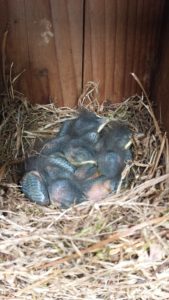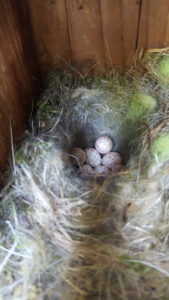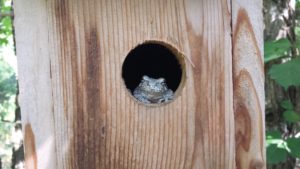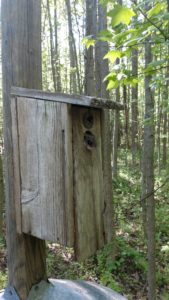Nesting Boxes: Nests, Eggs, Chicks, and Surprises
Installing nesting structures, like bird nesting boxes, can be a great way to help wildlife. If properly installed and maintained, nesting boxes can provide a critical component of habitat for wildlife. And as with all things natural — nesting structures can provide a few delightful surprises. This has certainly been the case for the bluebird boxes on our property.
Bluebird Boxes:
A bluebird box is an artificial nesting structure designed specifically to suit bluebirds. In our case on the Eastern Shore of Maryland, we are trying to help the Eastern Bluebird (Sialia sialis). The Eastern Bluebird is a cavity nester. They build a neat nest of grass or pine needles in holes in trees. As trees with holes disappeared due to forestry management and non-native birds were introduced that compete for nesting cavities (House Sparrows and European Starlings), Eastern Bluebird populations suffered dramatic declines.
Fortunately, Eastern Bluebirds readily adapt to artificial nesting structures and nesting boxes have been critical in arresting and reversing the Eastern Bluebird’s population decline. Today, estimates place the Eastern Bluebird population at 22 million and the IUCN lists it as a species of least concern.

Bluebird Chicks: Eastern Bluebird populations have rebounded, in part, due to the installation and maintenance of man-made nesting structures. But there are many other species of wildlife that can benefit from bluebird boxes. Photo courtesy of Chris Pupke.
Nesting Box Plans:
How to build a nesting box. There are myriad plans for building Bluebird Nesting Boxes –I will leave it to the reader to find one that works best for them. In general, a box made of untreated wood that is approximately 4 inches x 6 inches x 9 inches with a circular hole 1.5 inches in diameter should work in most places.
Each nesting box should be mounted on 4”x4” post about four or five feet off the ground and the post must have a predator guard on it to prevent foxes, raccoons, snakes or other predators from giving you a cruel surprise. The nesting boxes must be monitored weekly to prevent House Sparrows from taking over the box. More information on bluebird boxes can be found at the National Bluebird Society’s webpage: http://www.nabluebirdsociety.org/
Bluebird Nesting:
Bluebird nesting boxes can be a great way to invite birds to nest on your property. But they also can be a great way to introduce people to wildlife. It presents an opportunity for a child or adult to follow nest construction, egg laying, and chick raising.
The excitement starts when you see a male perched on top of the box singing; alerting potential mates about what a great find he has discovered for her. Soon after you may spot the birds bringing in nesting material. Depending on the species, it could be grasses, pine needles, sticks, moss, feathers and even a snake skin. Once the nest is complete, a carefully managed maintenance routine can provide a cautious monitor with a glimpse of the eggs from which the chicks soon emerge.

Carolina Chickadee Eggs: Carolina Chickadee nest with eggs in a bluebird box. Photo courtesy of Chris Pupke.
Related Blog: State Wildlife Agencies Have to Evolve
Bluebird Nesting Boxes At My Home:
My wife and I have installed ten bluebird nesting boxes on our 43 acre property on the Eastern Shore of Maryland. The property consists of about 20 acres of mature woodlands, 20 acres of an old agricultural field that has not been worked since we bought the property, some pocket wetlands and a small meadow. We have two nesting boxes near the house, two out in the meadow, one by the barn and the rest are scattered along our walking trails. Over the almost twenty years we have lived here, these boxes have provided countless memories.
But twenty years is a long time in the life of an old field and the trees that once were knee high now soar to thirty feet or more. The impact this growth has had on our bluebird population is notable. We no longer expect to have several bluebird pairs nesting multiple times a season. In fact in recent years, we rejoice when we have just one nest like last year. So far this year, we have not experienced that particular joy. However, nature has filled this void in wonderful and surprising ways.
More Than Just Bluebirds:
The boxes we installed to provide nesting cavities for bluebirds have been readily adopted by a host of wildlife. We always knew that some of the bluebird boxes would be used by Tree Swallows (Tachycineta bicolor) and White-footed Mice (Peromyscus leucopus). However, as the old field has matured into a young forest, the Tree Swallows have moved on to habitat better suited for them.

Gray Treefrog: One of my favorite bluebird box occupants is the gray treefrog. Note the suction cup like toes that help them climb trees (and bluebird boxes). Photo courtesy of Chris Pupke.
We also knew that as the old field matured, Carolina Chickadees (Poecile carolinensis) and Tufted Titmice (Baeolophus bicolor) would start using the boxes more frequently. These birds prefer more wooded areas for nesting.

Flying Squirrel: Southern flying squirrels will use the bluebird boxes closest to the mature woodland on our property. Spotting a flying squirrel in one of our boxes is a great thrill. Photo courtesy of Chris Pupke.
The biggest surprise for us has been the ready adoption of these nesting boxes by Grey Treefrogs (Hyla versicolor) and Northern Flying Squirrels (Glaucomys Volans). When these species move into one of the boxes, they remind us of the great diversity of nature and its many surprises. They also remind us that when we undertake work for the benefit of one species, other species will also benefit.
Start improving wildlife habitat in your backyard
Bluebird boxes and other nesting structures can be a “gateway wildlife habitat improvement” — a way to get people to start improving habitat for wildlife. Witnessing the nesting cycle is a powerful inducement to caring for wildlife and restoring their habitat. And if people don’t get any bluebirds in their bluebird boxes, they can learn about some wildlife that they did not know were in the neighborhood.
As a “gateway” to more appreciation for wildlife and their needs, nesting boxes have helped interest private landowners in the work of Biophilia Foundation and our grantees. By donating to our large scale project and/or allowing wildlife habitat restoration on their property, many landowners have helped wildlife survive and have linked critical wildlife corridors together.
Read about the Wildlife Corridors project.
Read about Monarch Habitat Preservation
Sources:
https://abcbirds.org/bird/eastern-bluebird/
https://www.allaboutbirds.org/guide/Eastern_Bluebird/lifehistory
https://www.audubon.org/field-guide/bird/eastern-bluebird
http://www.nabluebirdsociety.org/nestbox-plans/
Henderson, Carrol L.; Woodworking for Wildlife; State of Minnesota, Department of Natural Resources; 1992.

Recent Comments